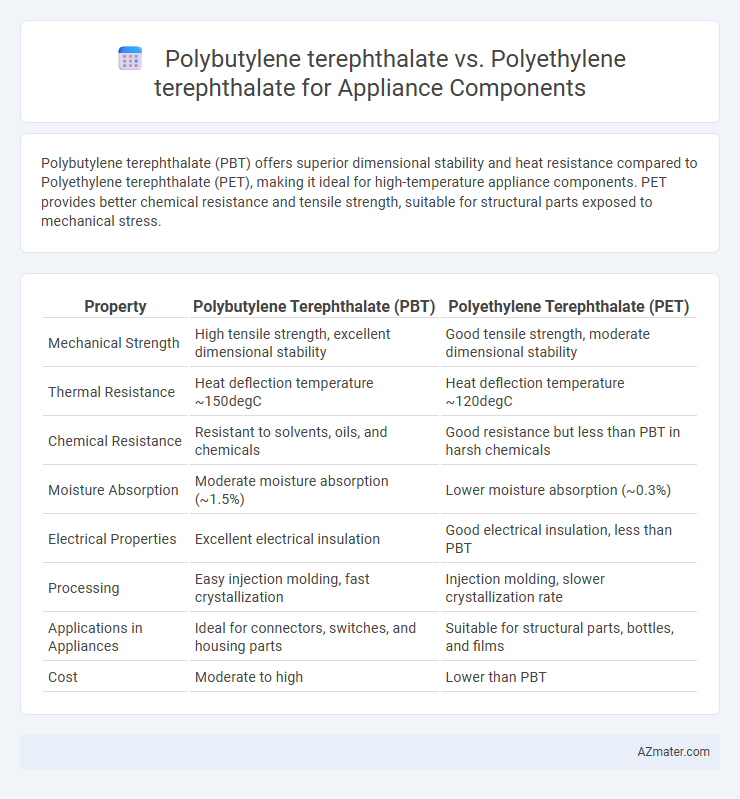Polybutylene terephthalate (PBT) offers superior dimensional stability and heat resistance compared to Polyethylene terephthalate (PET), making it ideal for high-temperature appliance components. PET provides better chemical resistance and tensile strength, suitable for structural parts exposed to mechanical stress.
Table of Comparison
| Property | Polybutylene Terephthalate (PBT) | Polyethylene Terephthalate (PET) |
|---|---|---|
| Mechanical Strength | High tensile strength, excellent dimensional stability | Good tensile strength, moderate dimensional stability |
| Thermal Resistance | Heat deflection temperature ~150degC | Heat deflection temperature ~120degC |
| Chemical Resistance | Resistant to solvents, oils, and chemicals | Good resistance but less than PBT in harsh chemicals |
| Moisture Absorption | Moderate moisture absorption (~1.5%) | Lower moisture absorption (~0.3%) |
| Electrical Properties | Excellent electrical insulation | Good electrical insulation, less than PBT |
| Processing | Easy injection molding, fast crystallization | Injection molding, slower crystallization rate |
| Applications in Appliances | Ideal for connectors, switches, and housing parts | Suitable for structural parts, bottles, and films |
| Cost | Moderate to high | Lower than PBT |
Introduction to PBT and PET in Appliance Manufacturing
Polybutylene terephthalate (PBT) and Polyethylene terephthalate (PET) are widely used thermoplastics in appliance component manufacturing due to their excellent mechanical properties and thermal stability. PBT offers superior electrical insulation and chemical resistance, making it ideal for motor housings and connectors, while PET provides higher rigidity and dimensional stability, suitable for structural parts and transparent components. Manufacturers choose between PBT and PET based on specific appliance requirements such as impact resistance, moisture absorption, and operational temperature range.
Chemical Structure and Material Composition
Polybutylene terephthalate (PBT) features a four-carbon butylene glycol segment in its polymer chain, contrasting with polyethylene terephthalate (PET), which contains a two-carbon ethylene glycol unit; this structural difference impacts flexibility and crystallization rates. PBT's molecular composition grants enhanced dimensional stability and superior resistance to hydrolysis and chemicals, making it more suitable for appliance components exposed to moisture and heat. PET's higher melting point and rigidity favor applications requiring structural strength but can be less resilient under long-term thermal stress compared to PBT.
Mechanical Properties Comparison
Polybutylene terephthalate (PBT) exhibits superior impact resistance and dimensional stability compared to Polyethylene terephthalate (PET), making it ideal for appliance components subjected to mechanical stress. PBT's tensile strength ranges between 50-70 MPa, while PET typically offers 55-75 MPa, but PBT's higher elongation at break enhances its toughness under dynamic loads. Additionally, PBT's lower moisture absorption contributes to maintaining mechanical integrity in humid environments, a critical factor for durable appliance functionality.
Thermal Performance and Heat Resistance
Polybutylene terephthalate (PBT) exhibits superior thermal performance and higher heat resistance compared to Polyethylene terephthalate (PET), making it more suitable for appliance components exposed to elevated temperatures. PBT maintains dimensional stability and mechanical strength at temperatures up to 150degC, while PET typically withstands temperatures only up to 120degC before deforming. The enhanced crystallinity and lower moisture absorption of PBT contribute to its better performance under thermal stress in household appliance applications.
Electrical Insulation Capabilities
Polybutylene terephthalate (PBT) offers superior electrical insulation properties compared to Polyethylene terephthalate (PET), with higher dielectric strength and better resistance to electrical tracking, making it ideal for appliance components exposed to high voltages. PBT exhibits excellent dimensional stability and low moisture absorption, which enhances its insulating performance in humid environments. PET, while mechanically robust, typically demonstrates lower dielectric strength and higher water uptake, reducing its effectiveness as an electrical insulator in demanding appliance applications.
Processing and Manufacturability
Polybutylene terephthalate (PBT) exhibits superior mold flow and dimensional stability compared to Polyethylene terephthalate (PET), making it highly suitable for complex appliance components requiring precision. PBT's lower melting point (approximately 223degC) enables faster cycle times and reduced thermal degradation during injection molding, enhancing manufacturability. Conversely, PET's higher melting point (around 260degC) demands more energy-intensive processing and can lead to increased warpage, limiting its ease of manufacture in intricate appliance parts.
Cost Efficiency and Market Availability
Polybutylene terephthalate (PBT) offers superior dimensional stability and chemical resistance compared to polyethylene terephthalate (PET), making it a cost-efficient choice for appliance components exposed to heat and moisture. In terms of market availability, PET is more widely produced and accessible due to its extensive use in packaging and textiles, often resulting in lower raw material costs. However, the specialized application benefits of PBT in durability and performance often justify its higher price point in appliance manufacturing.
Durability and Long-Term Reliability in Appliances
Polybutylene terephthalate (PBT) offers superior dimensional stability and excellent resistance to heat and chemicals, making it ideal for long-term reliability in appliance components exposed to high temperatures and mechanical stress. Polyethylene terephthalate (PET) provides good strength and stiffness but tends to have lower thermal resistance compared to PBT, limiting its durability under prolonged heat exposure. The enhanced hydrolysis resistance of PBT further ensures consistent performance in humid or wet appliance environments, contributing to longer service life compared to PET.
Environmental Impact and Recyclability
Polybutylene terephthalate (PBT) and Polyethylene terephthalate (PET) differ significantly in environmental impact and recyclability for appliance components. PET is more widely recycled due to established infrastructure, yielding lower carbon emissions and reduced landfill waste compared to PBT. PBT's chemical resistance and durability offer a longer lifecycle, yet its recycling processes are less developed, posing challenges in circular economy integration.
Applications and Case Studies in Appliance Components
Polybutylene terephthalate (PBT) and Polyethylene terephthalate (PET) are widely used in appliance components due to their durability and thermal stability. PBT excels in electrical connectors, appliance housings, and switches because of its superior dimensional stability and resistance to heat and chemicals, as demonstrated in case studies involving washing machine motor components and dishwasher racks. PET is preferred for transparent or semi-transparent parts, such as appliance panels and refrigerator shelves, offering high strength and good surface finish, with case studies highlighting its effective use in refrigerator door bins and microwave oven panels.

Infographic: Polybutylene terephthalate vs Polyethylene terephthalate for Appliance Component
 azmater.com
azmater.com